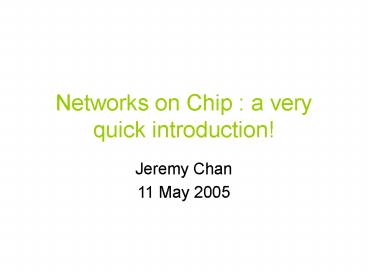Networks on Chip : a very quick introduction! - PowerPoint PPT Presentation
Title:
Networks on Chip : a very quick introduction!
Description:
Pentium 4 has two dedicated drive stages to transport signals across chip ... Analyse / Profile. Configure. Refine. NoC Optimisation. No. Synthesis. Optimized. NoC ... – PowerPoint PPT presentation
Number of Views:227
Avg rating:3.0/5.0
Title: Networks on Chip : a very quick introduction!
1
Networks on Chip a very quick introduction!
- Jeremy Chan
- 11 May 2005
2
Overview of Talk
- Introduction
- SoC Design Trends (communication centric design)
- Communication Centric Design
- Application Modeling
- Energy Modeling
- NoC Optimization
- Conclusions
3
SoC Design Trends
Source Kanishka Lahiri 2004
Source Ron Ho, Stanford 1999
- Focus on communication-centric design
- Poor wire scaling
- High Performance
- Energy efficiency
- Communication architecture large proportion of
energy budget
4
SoC Design Trends
- MPSoC STI Cell
- Eight Synergistic Processing Elements
- Ring-based Element Interconnect Bus
- 128-bit, 4 concentric rings
- Interconnect delays becoming important
- Pentium 4 has two dedicated drive stages to
transport signals across chip
Source Pham et al ISSCC 2005
5
The SoC nightmare
System Bus
DMA
CPU
DSP
Mem Ctrl.
Bridge
The Board-on-a-Chip Approach
The architecture is tightly coupled
MPEG
I
o
o
C
Control Wires
Peripheral Bus
Source Prof Jan Rabaey CS-252-2000 UC Berkeley
6
On-chip Communication
Irregular architectures
Bus-based architectures
Regular Architectures
- Bus based interconnect
- Low cost
- Easier to Implement
- Flexible
- Networks on Chip
- Layered Approach
- Buses replaced with Networked architectures
- Better electrical properties
- Higher bandwidth
- Energy efficiency
- Scalable
7
Network on Chip
Queuing Theory
Traffic Modeling
Software
Architectures
Transport
Network
Separation of concerns
Wiring
Networking
- Networks on Chip
- Layered Approach
- Buses replaced with Networked architectures
- Better electrical properties
- Higher bandwidth
- Energy efficiency
- Scalable
8
Regular Network on Chip
PE
PE
PE
PE
PE
PE
PE
PE
PE
9
Typical NoC Router
Crossbar Switch
LC
FC
LC
FC
LC
FC
LC
FC
LC
FC
Routing
Arbitration
10
NoC Issues
- Application Specific Optimization
- Buffers
- Routing
- Topology
- Mapping to topology
- Implementation and Reuse
11
NoC Issues
o1 o2 o3 o4
- I1 - -
- I3 - I1
- - - -
- - - -
o1 o2 o3 o4
- - - -
- I1 - -
- I1 - -
- - - -
- Architecture
- QoS Support
- What topology will suit a particular application?
- Fault tolerance
- Gossiping architectures
X
BQ
GQ
BQ
GQ
arbiter
slot table
12
Communication Centric Design
Application
Architecture Library
Architecture / Application Model
NoC Optimisation
Configure
Refine
Evaluate
Analyse / Profile
Good?
No
Optimized NoC
Synthesis
13
How are application described?
ARM2.5ms PPC 2.2ms
- Few multiprocessor embedded benchmarks
- Task graphs
- Extensively used in scheduling research
- Each node has computation properties
- Directed edge describes task dependences
- Edge properties has communication volume
SRC
15000
FFT
4000
15000
matrix
FIR
82500
IFFT
4000
40000
angle
15000
SINK
14
Simplifying Application Model
- With simple energy model,
- Ebit nhops x ESbit (nhops 1) x ELbit
- nhops proportional to energy consumption
- Can abstract communication design problem to
PE1
PE2
PE3
15
Simple Router Energy Models
- Hu et al assume
- Ebit ESbit EBbit EWbit ELbit
- Simplifying assumptions
- Buffer implemented using latches and flip-flops
- Negligible Internal wire energy
- gt Ebit ESbit EBbit EWbit ELbit
- Router to Router Energy (minimal routing)
- Ebit nhops x ESbit (nhops 1) x ELbit
16
Energy-Aware Task mapping
- Reduce Energy Consumption by placing
- Addressed by Hu et al 2002
- Given a CTG and a heterogenous NoC
- Find
- A mapping function M tasks(T) gt PEs (P)
- Assuming the tasks are already scheduled and
partitioned - Solution formulated as a quadratic assignment
problem and solved using Branch and Bound with
heuristics
17
Energy Model Limitations
- Ignore
- Static energy i.e. leakage power
- Clock energy flip flops, latches need to be
clocked - Buffering Energy is not free
- can consume 50-80 of total communication
architecture depending on size and depth of FIFOs
18
NoC Generation
- Given a parameterized NoC architecture and
library of NoC components, generate a
synthesizable HDL model.
19
NoC Generation
- Most packet switched routers contain similar
components that are connected - Can be easily modularized to allow automatic
generation
20
Typical NoC Router
Crossbar Switch
LC
FC
LC
FC
LC
FC
LC
FC
LC
FC
Routing
Arbitration
21
Current Research
- Irregular Topology Generation
- Formulated as MILP problems
- Genetic algorithm Solution
- Buffer Allocation Problem
- Assumed Poisson Distributed Traffic
- Used Queuing Theory to Determine Ideal Buffering
for Ports gt non uniform buffering depths - Integrated solution to optimization problems
22
Summary
- NoC is an exciting research area that will lead
to an paradigm shift in SoC design. - NoC research is still in infancy
- Many open research problems
- Need better application and traffic models, new
optimization techniques - New Power, Performance, Traffic Models being
developed
23
Thank You































